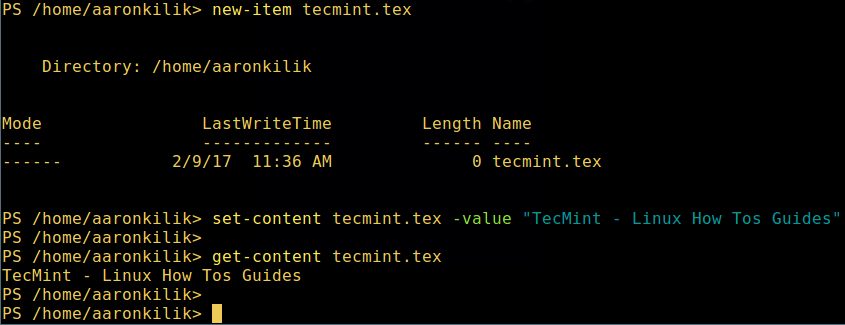微软爱上 Linux:当 PowerShell 来到 Linux 时
============================================================
在微软爱上 Linux 之后,**PowerShell** 这个原本只是 Windows 才能使用的组件,于 2016 年 8 月 18 日开源并且成为跨平台软件,登陆了 Linux 和 macOS。
**PowerShell** 是一个微软开发的自动化任务和配置管理系统。它基于 .NET 框架,由命令行语言解释器(shell)和脚本语言组成。
PowerShell 提供对 **COM** (组件对象模型) 和 **WMI** (Windows 管理规范) 的完全访问,从而允许系统管理员在本地或远程 Windows 系统中 [执行管理任务][1],以及对 WS-Management 和 CIM(公共信息模型)的访问,实现对远程 Linux 系统和网络设备的管理。
通过这个框架,管理任务基本上由称为 **cmdlets**(发音 command-lets)的 **.NET** 类执行。就像 Linux 的 shell 脚本一样,用户可以通过按照一定的规则将一组 **cmdlets** 写入文件来制作脚本或可执行文件。这些脚本可以用作独立的[命令行程序或工具][2]。
### 在 Linux 系统中安装 PowerShell Core 6.0
要在 Linux 中安装 **PowerShell Core 6.0**,我们将会用到微软软件仓库,它允许我们通过最流行的 Linux 包管理器工具,如 [apt-get][3]、[yum][4] 等来安装。
#### 在 Ubuntu 16.04 中安装
首先,导入该公共仓库的 **GPG** 密钥,然后将 **Microsoft Ubuntu** 仓库注册到 **APT** 的源中来安装 **PowerShell**:
```
$ curl https://packages.microsoft.com/keys/microsoft.asc | sudo apt-key add -
$ curl https://packages.microsoft.com/config/ubuntu/16.04/prod.list | sudo tee /etc/apt/sources.list.d/microsoft.list
$ sudo apt-get update
$ sudo apt-get install -y powershell
```
#### 在 Ubuntu 14.04 中安裝
```
$ curl https://packages.microsoft.com/keys/microsoft.asc | sudo apt-key add -
$ curl https://packages.microsoft.com/config/ubuntu/14.04/prod.list | sudo tee /etc/apt/sources.list.d/microsoft.list
$ sudo apt-get update
$ sudo apt-get install -y powershell
```
#### 在 CentOS 7 中安裝
首先,将 **Microsoft RedHat** 仓库注册到 **YUM** 包管理器仓库列表中,然后安装 **PowerShell**:
```
$ sudo curl https://packages.microsoft.com/config/rhel/7/prod.repo > /etc/yum.repos.d/microsoft.repo
$ sudo yum install -y powershell
```
### 如何在 Linux 中使用 PowerShell Core 6.0
在这一节中,我们将会简单介绍下 **PowerShell**;我们将会看到如何启动 PowerShell,运行一些基础命令,操作文件、目录和进程。然后学习怎样列出所有可用的命令、显示命令帮助和别名。
输入以下命令来启动 PowerShell:
```
$ powershell
```
[

][5]
*在 Linux 中启动 PowerShell*
你可以通过以下命令来查看 PowerShell 版本:
```
$PSVersionTable
```
[

][6]
*查看 PowerShell 版本*
在 Linux 中运行基本的 PowerShell 命令。
```
get-date [# 显示当前日期]
get-uptime [# 显示开机时间]
get-location [# 显示当前工作目录]
```
#### 在 PowerShell 中操作文件和目录
1、 可以通过两种方法创建空文件:
```
new-item tecmint.tex
或者
"">tecmint.tex
```
然后往里面添加内容并查看文件内容。
```
set-content tecmint.tex -value "TecMint Linux How Tos Guides"
get-content tecmint.tex
```
[

][7]
*在 PowerShell 中创建新文件*
2、 在 PowerShell 中删除一个文件
```
remove-item tecmint.tex
get-content tecmint.tex
```
[

][8]
*在 PowerShell 中删除一个文件*
3、 创建目录
```
mkdir tecmint-files
cd tecmint-files
“”>domains.list
ls
```
[

][9]
*在 PowerShell 中创建目录*
4、 执行长格式的列表操作,列出文件/目录详细情况,包括模式(文件类型)、最后修改时间等,使用以下命令:
```
dir
```
[

][10]
*Powershell 中列出目录长列表*
5、 显示系统中所有的进程:
```
get-process
```
[

][11]
*在 PowerShell 中显示运行中的进程*
6、 通过给定的名称查看正在运行的进程/进程组细节,将进程名作为参数传给上面的命令,如下:
```
get-process apache2
```
[

][12]
*在 PowerShell 中查看指定的进程*
输出中各部分的含义:
* NPM(K) – 进程使用的非分页内存,单位:Kb。
* PM(K) – 进程使用的可分页内存,单位:Kb。
* WS(K) – 进程的工作集大小,单位:Kb,工作集由进程所引用到的内存页组成。
* CPU(s) – 进程在所有处理器上所占用的处理器时间,单位:秒。
* ID – 进程 ID (PID).
* ProcessName – 进程名称。
7、 想要了解更多,获取 PowerShell 命令列表:
```
get-command
```
[

][13]
*列出 PowerShell 的命令*
8、 想知道如何使用一个命令,查看它的帮助(类似于 Unix/Linux 中的 man);举个例子,你可以这样获取命令 **Describe** 的帮助:
```
get-help Describe
```
[

][14]
*PowerShell 帮助手册*
9、 显示所有命令的别名,輸入:
```
get-alias
```
[

][15]
*列出 PowerShell 命令别名*
10、 最后,不过也很重要,显示命令历史记录(曾运行过的命令的列表):
```
history
```
[

][16]
*显示 PowerShell 命令历史记录*
就是这些了!在这篇文章里,我们展示了如何在 Linux 中安装**微软的 PowerShell Core 6.0**。在我看来,与传统 Unix/Linux 的 shell 相比,PowerShell 还有很长的路要走。目前看来,PowerShell 还需要在命令行操作机器,更重要的是,编程(写脚本)等方面,提供更好、更多令人激动和富有成效的特性。
查看 PowerShell 的 GitHub 仓库:[https://github.com/PowerShell/PowerShell][17]。
请在评论中分享你的观点。
--------------------------------------------------------------------------------
作者简介:
Aaron Kili 是一个 Linux 和 F.O.S.S 狂热爱好者,将来的 Linux 系统管理员、web 开发者,目前是 TecMint 的内容编辑,是一个热爱研究计算机与坚定的分享知识的人。
--------------------------------------------------------------------------------
via: http://www.tecmint.com/install-powershell-in-linux/
作者:[Aaron Kili][a]
译者:[zijung](https://github.com/zijung)
校对:[jasminepeng](https://github.com/jasminepeng)
本文由 [LCTT](https://github.com/LCTT/TranslateProject) 原创编译,[Linux中国](https://linux.cn/) 荣誉推出
[a]:http://www.tecmint.com/author/aaronkili/
[1]:http://www.tecmint.com/using-shell-script-to-automate-linux-system-maintenance-tasks/
[2]:http://www.tecmint.com/tag/commandline-tools/
[3]:http://www.tecmint.com/useful-basic-commands-of-apt-get-and-apt-cache-for-package-management/
[4]:http://www.tecmint.com/20-linux-yum-yellowdog-updater-modified-commands-for-package-mangement/
[5]:http://www.tecmint.com/wp-content/uploads/2017/02/start-powershell.png
[6]:http://www.tecmint.com/wp-content/uploads/2017/02/check-powershell-version.png
[7]:http://www.tecmint.com/wp-content/uploads/2017/02/Create-New-File-in-Powershell.png
[8]:http://www.tecmint.com/wp-content/uploads/2017/02/Delete-File-in-Powershell.png
[9]:http://www.tecmint.com/wp-content/uploads/2017/02/create-new-directory-in-Powershell.png
[10]:http://www.tecmint.com/wp-content/uploads/2017/02/Directory-Long-Listing-in-Powershell.png
[11]:http://www.tecmint.com/wp-content/uploads/2017/02/View-Running-Processes-in-Powershell.png
[12]:http://www.tecmint.com/wp-content/uploads/2017/02/View-Specific-Process-in-Powershell.png
[13]:http://www.tecmint.com/wp-content/uploads/2017/02/List-Powershell-Commands.png
[14]:http://www.tecmint.com/wp-content/uploads/2017/02/Powershell-Help-Manual.png
[15]:http://www.tecmint.com/wp-content/uploads/2017/02/List-Powershell-Command-Aliases.png
[16]:http://www.tecmint.com/wp-content/uploads/2017/02/List-Powershell-Command-History.png
[17]:https://github.com/PowerShell/PowerShell
[18]:http://www.tecmint.com/author/aaronkili/
[19]:http://www.tecmint.com/10-useful-free-linux-ebooks-for-newbies-and-administrators/
[20]:http://www.tecmint.com/free-linux-shell-scripting-books/